Lago Strobel (aka Jurassic Lake)
February 2016
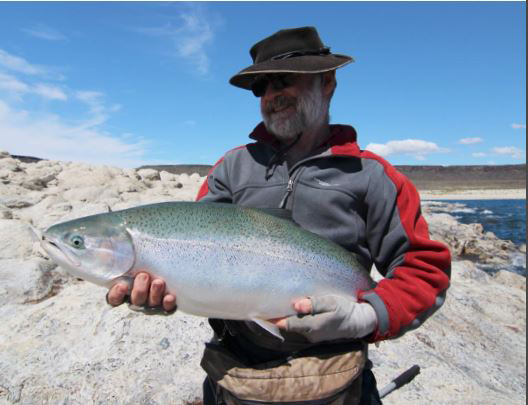
Newly stocked trout lakes often go through a boom period where the average size of the fish becomes abnormally high. Tasmania’s Great Lake, for example, was first stocked with brown trout in 1870, and within a few years it was producing fish averaging ten pounds with plenty up to twenty. Robust natural recruitment took place, but the typical size remained more or less static until 1912, when major modification of the natural system and artificial stocking with rainbow trout heralded an entirely new fishing experience.
Photos taken in the 1890s of strings of giant Great Lake trout fired my childhood imagination, and I wondered if anything like it would ever happen in Tasmania again. It did. In 1975 a newly formed hydro-electric impoundment, Lake Pedder, began yielding brown trout which again averaged ten pounds with plenty up to twenty. But this time the boom was short-lived. Within four years the fishery had gone into decline – the victim of not just the normal ‘boom and bust’ cycle that usually affects impoundments, but also the mysterious collapse of the native baitfish population. By the time I visited Pedder as a teenager in 1981, the fishery was a shadow of its former self. I felt as if I’d missed my last-ever chance of experiencing a major ‘boom fishery’.
In the early 2000s, however, stories began to circulate about Argentina’s Lago Strobel, a recently seeded lake in Santa Cruz province which had begun producing rainbow trout so big that it had been nicknamed Jurassic Lake. The problem was that access was totally controlled by two commercial lodges, both of which charged a thousand US dollars per person per day. Since I couldn’t afford these rates, I sort of hoped that the fishing would quickly crash so I could stop wasting time fantasising about it.
It didn’t crash, though, and in January 2016, I finally gave in to temptation. Frances and I booked a ‘half week’ stay at Estancia Laguna Verde. All we had to do was get ourselves to the airport at El Calafate, and the lodge operators would organise everything from there on, including the five-hour drive north along the lonely, desolate Ruta 40.
On the road to Strobel
Buenos Aires may be the second-biggest city in South America, but you don’t have to fly too far south before the land becomes distinctly rural. By the time you reach the northern border of the southernmost mainland province, Santa Cruz, the landscapes are unrelentingly harsh: countless square kilometres of uninhabited steppe pockmarked with volcanic craters and crater lakes, and interspersed with the odd huge river draining from the cordillera of the Andes, hundreds of kilometres to the west.
At El Calafate’s small airport, the jovial driver of Estancia Laguna Verde’s minibus introduced himself as Ricardo and apologised for not being able to speak English. ‘No hay problema,’ I replied. In the months leading up to this trip, I’d put a huge effort into improving my Spanish (or Castellano, as they prefer to call it in Latin America), listening to stacks of audio books and watching Latin American movies.
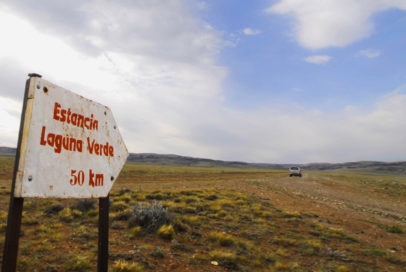 Ruta 40 was an adventure in itself, the águila (eagle) and sky-blue background on the iconic road sign appropriately evocative. Two and half hours out from El Calafate, near the settlement of Tres Lagos (Three Lakes), the paved section of ‘highway’ abruptly ended. Ahead were long-abandoned roadworks, and recent rain meant that the unfinished gravel surface had become a series of deep ruts. ‘I’m glad we didn’t attempt to drive ourselves to Strobel,’ I said. ‘Not in a little hire car.’
Ruta 40 was an adventure in itself, the águila (eagle) and sky-blue background on the iconic road sign appropriately evocative. Two and half hours out from El Calafate, near the settlement of Tres Lagos (Three Lakes), the paved section of ‘highway’ abruptly ended. Ahead were long-abandoned roadworks, and recent rain meant that the unfinished gravel surface had become a series of deep ruts. ‘I’m glad we didn’t attempt to drive ourselves to Strobel,’ I said. ‘Not in a little hire car.’
 ‘The road is rough the whole of the rest of the way,’ Ricardo agreed. ‘It’s been under construction for years. Nothing gets done quickly in Argentina.’ He pointed to some surreal structures that might have been streetlights. ‘SOS towers, but they will rust into the ground before they’re ever fitted with phones.’ Then, abruptly, he pointed out a pickup travelling towards us and announced that it was time to change vehicles. ‘Your new driver will be Christian, who will also be your guide. I’ll be taking his passengers back to El Calafate, and he will take you on to Strobel.’
‘The road is rough the whole of the rest of the way,’ Ricardo agreed. ‘It’s been under construction for years. Nothing gets done quickly in Argentina.’ He pointed to some surreal structures that might have been streetlights. ‘SOS towers, but they will rust into the ground before they’re ever fitted with phones.’ Then, abruptly, he pointed out a pickup travelling towards us and announced that it was time to change vehicles. ‘Your new driver will be Christian, who will also be your guide. I’ll be taking his passengers back to El Calafate, and he will take you on to Strobel.’
Christian was clearly a local so I talked to him in Castellano, but he answered in English: a pattern which we maintained for the rest of our time together.
‘Where did Argentina’s rainbow trout come from?’ I asked him.
‘Rainbows were first introduced to Patagonia from New York in 1904, but most died in transit. A more successful shipment arrived in 1905 and were taken to a hatchery on the shore of Lago Nahuel Huapí at the foot of the Andes about halfway down the Chilean border. Santa Cruz got its first stocks in 1906.’
After an hour or so, a huge lake appeared on our left. ‘Lago Cardiel,’ Christian announced.
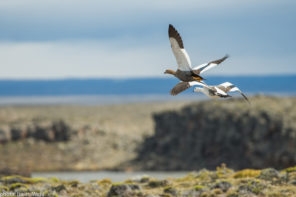 I’d read about this publicly accessible fishery before leaving Tasmania. Apparently it was stocked in the 1940s after a plane ferrying rainbow fry to Lago Fagnano on Tierra del Fuego was forced to make an emergency landing. No one really expected the fish to survive, but they thrived. Average catch rates are now said to be five to ten rainbows per angler per hour, most of which weigh one to two pounds, and there’s supposed to be a good chance of catching a few brook trout too. I’d been so intrigued that I arranged with the Laguna Verde agent for our driver to call in at the lake for an hour or two on our return trip to El Calafate.
I’d read about this publicly accessible fishery before leaving Tasmania. Apparently it was stocked in the 1940s after a plane ferrying rainbow fry to Lago Fagnano on Tierra del Fuego was forced to make an emergency landing. No one really expected the fish to survive, but they thrived. Average catch rates are now said to be five to ten rainbows per angler per hour, most of which weigh one to two pounds, and there’s supposed to be a good chance of catching a few brook trout too. I’d been so intrigued that I arranged with the Laguna Verde agent for our driver to call in at the lake for an hour or two on our return trip to El Calafate.
After another half-hour we finally passed the north-eastern end of Cardiel and turned off Ruta 40 onto a private road belonging to Estancia Cardiel. The land here was a terrace of plateaus, their boundaries as ill-defined as their names: Meseta Negra, Meseta Central, Meseta de Strobel and, my favourite, Meseta del Muerte (the Plateau of Death). There was nothing but red-brown basalt as far as the eye could see, and it was unbelievably dry. ‘We rely mostly on snowfall,’ Christian explained, ‘and with climate change there’s less and less of it. Eleven years ago when I first fished here, Strobel was said to be eighty to ninety metres deep, but it has dropped three metres since then.’
The road quickly devolved into a rugged track. And as dry as the land was, we started to see much more wildlife than had been obvious from Ruta 40 – mainly small herds of guanacos and flocks of rheas. Another hour went by before we reached the diminutive Río Moro with its chain of small lagoons, reminiscent of the Western Lakes. ‘The whole system is full of wild rainbows averaging three to five pounds,’ Christian assured us on our approach and, sure enough, as the pickup forded the creek several big fish almost beached themselves in panic.
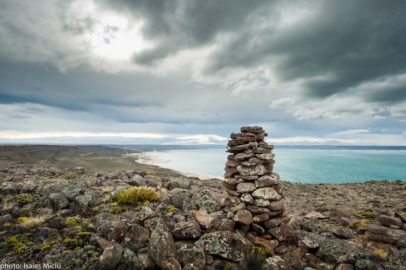
Christian also pointed out a system of tall cairns built hundreds or even thousands of years ago by the Tehuelche or Mapuche. ‘On the estancia there are ancient meeting areas with rock art,’ he said, ‘and you will find obsidian flakes and arrowheads all over the place.’
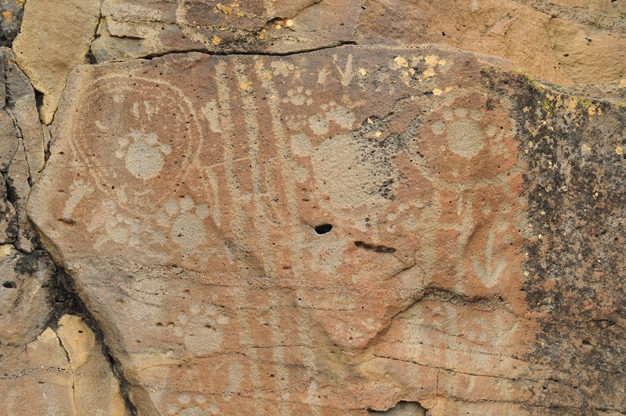
The lodge
Our accommodation was on the shores of a small lake, Laguna Verde, just out of sight of Strobel. It was a modest farmhouse and very comforting. Our hostess, Tami, met us at the door, and like most people at Laguna Verde she spoke perfect English. After showing us around – there was a large lounge and dining area, and our bedroom had its own modest en suite – she asked for our waders and boots. ‘We need to quickly disinfect them to minimise the risk of introducing invasive plants and animals like didymo and New Zealand mud snails.’
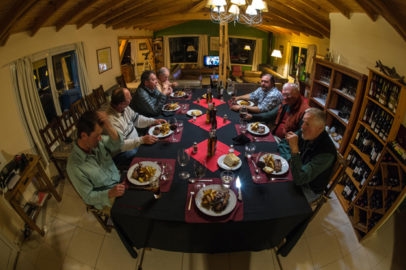 Soon enough we met the cheery chef, Mane, and cleaner, Pau, and we were offered Quilmes beer and homemade pizza. But there were fish rising in Laguna Verde, so we quickly made our way down to the foreshore. The water was slightly turbid and green, so polaroiding was difficult, but numerous three- to five-pound rainbows ate our black Woolly Buggers, as did a large brook trout and . ‘This is one of the few lakes that’s sometimes stocked with hatchery-reared fry and fingerlings,’ Christian conceded before suggesting we explore some of the nearby chain lakes, where we had great fun polaroiding the edges for abundant wild rainbows.
Soon enough we met the cheery chef, Mane, and cleaner, Pau, and we were offered Quilmes beer and homemade pizza. But there were fish rising in Laguna Verde, so we quickly made our way down to the foreshore. The water was slightly turbid and green, so polaroiding was difficult, but numerous three- to five-pound rainbows ate our black Woolly Buggers, as did a large brook trout and . ‘This is one of the few lakes that’s sometimes stocked with hatchery-reared fry and fingerlings,’ Christian conceded before suggesting we explore some of the nearby chain lakes, where we had great fun polaroiding the edges for abundant wild rainbows.
As in most places in Argentina, la comida (the evening meal) was served after 9pm, and this was when we got to meet our fellow clients. Peter, an older but fit Englishman, could easily have been a character played by Bill Nighy. I asked what he did for a living, and he replied in an impossibly posh accent, ‘Nothing as important as my friend Steven. He will be too modest to tell you himself, but he is the UN ambassador to Chad. We met because my wife also worked with the UN.’ There were two other frightfully well-spoken Englishmen, Nigel and his twenty-something son, Max, who ran a fishing lodge in the Bahamas and meticulously fostered a roguish, unkempt appearance. Less exuberant and less fit, but equally interesting, were two middle-aged men: Jan from Denmark, and Brad from Minnesota.
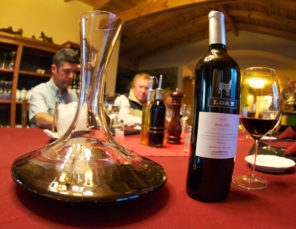 Frances had a go at talking about the more interesting birdlife in the chain lakes – flamingos and the rare macá tobiano (hooded grebe) – but it was hard to turn the conversation away from fishing.
Frances had a go at talking about the more interesting birdlife in the chain lakes – flamingos and the rare macá tobiano (hooded grebe) – but it was hard to turn the conversation away from fishing.
The meal was excellent and so too was the local malbec, and eventually the conversation loosened up. Nigel spoke fondly and proudly of a daughter who was cycling through the Middle East. Brad berated the movie Fargo for its misrepresentation of Minnesota. Steven enthralled us with descriptions of Africa. And Peter threw in a confetti of wry little asides.
Lago Strobel
Next morning, after a leisurely breakfast, Christian herded Frances and me into his pickup. Fifteen minutes later we got our first glimpse of ‘the big lake’. ‘It’s almost fifty kilometres around and a hundred square kilometres in area,’ Christian emphasised.
 Set in a red-brown basalt crater, it was clearly a caldera lake. ‘The inflowing Río Barrancoso is quite big and flows year round, but evaporation is high because of the sun and wind, and there’s no outflow,’ Christian explained. ‘The lake is always collecting carbonate salts and is very alkaline. The white rocks around the edges are ordinary rocks covered with a tufa carbonate crust which formed under water when the lake was higher. Water like this is very good for crustaceans – scud and daphnia – and that’s why the trout grow so big. The system was first seeded by the previous owner of the estancia, Julio Citaddini. He put fish in Río Barrancoso in 1989, and again in 1996 when he got a government grant to create a commercial fish-harvesting business. But within a few years after the 1996 stocking, the fish had grown so big that sport fishing seemed a better idea. No other fish have ever been put into the system. Trout spawn naturally in the river, so there are small fish here now as well as big ones, but the ones fly fishermen catch still average almost ten pounds, and you’ll see plenty weighing fifteen and twenty pounds.’
Set in a red-brown basalt crater, it was clearly a caldera lake. ‘The inflowing Río Barrancoso is quite big and flows year round, but evaporation is high because of the sun and wind, and there’s no outflow,’ Christian explained. ‘The lake is always collecting carbonate salts and is very alkaline. The white rocks around the edges are ordinary rocks covered with a tufa carbonate crust which formed under water when the lake was higher. Water like this is very good for crustaceans – scud and daphnia – and that’s why the trout grow so big. The system was first seeded by the previous owner of the estancia, Julio Citaddini. He put fish in Río Barrancoso in 1989, and again in 1996 when he got a government grant to create a commercial fish-harvesting business. But within a few years after the 1996 stocking, the fish had grown so big that sport fishing seemed a better idea. No other fish have ever been put into the system. Trout spawn naturally in the river, so there are small fish here now as well as big ones, but the ones fly fishermen catch still average almost ten pounds, and you’ll see plenty weighing fifteen and twenty pounds.’
Cardiel, in its early years, habitually gave up fish of eight to fifteen pounds before natural over-recruitment eventually saw the average size plummet.
As we descended into the rim, Christian pointed out geographical features that the lodge had formally named: The Finger, Camelot, Monster Bay, even a bay called Tasmania. And also the wildlife: a juvenile águila mora (literally ‘blackberry eagle’) sitting beside its nest, a tucu tucu sprinting to its burrow, a guanaco monitoring us from a rocky prominence.
Within half an hour we’d pulled up at The Finger. The lake was calm, like the day before, which according to Christian was unusual and not good. A fearless zorro colorado (culpeo fox) came close and studied me as I walked across a tufa beach to dip my index finger into the lake. Despite a pH of 9.0 the water was crystal clear and almost tasteless. Several large fish were cruising a long cast off shore, and I asked Christian what size tippet and what flies we should use. ‘Fifteen pounds,’ he replied, ‘and Woolly Buggers or nymphs.’
The fish were numerous and enormous, but most were cruising without intent and some were doggo. When they wouldn’t respond to anything that Frances and I presented, I asked Christian to fish alongside us to show us how it was done. But he insisted that fishing with clients was strictly prohibited.
Later in the morning I noticed that some trout that were cruising deep over the sand were actively nymphing. My heaviest nymphs didn’t get down quick enough, but a cone-headed Zonker of improbable size ended up working a treat. The first fish weighed seven pounds or so and, as strong as any steelhead, it screamed off with fifty metres of backing. The next few were bigger and even harder to land. What in hell was going to happen when we hooked one of the many fifteen-pounders that we saw lazing about closer to the surface?
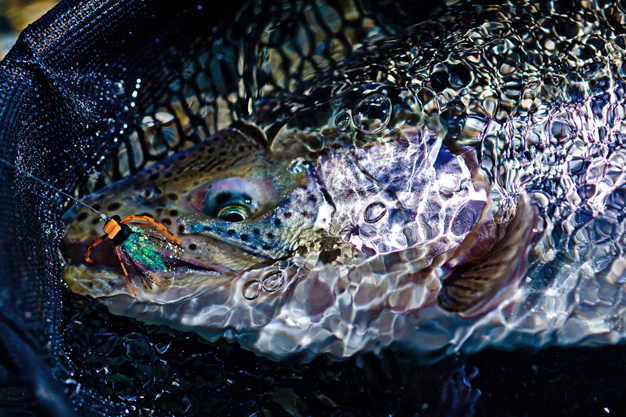 For el almuerzo (lunch), Christian drove us around to Tasmania Bay, where all the other guides and clients had gathered beside a purpose-built, three-sided hut. Not too many fish had been landed, even if Max and Nigel had done rather well, and the cooked meats, fresh salads and alcoholic drinks were a welcome way for people to reset their expectations.
For el almuerzo (lunch), Christian drove us around to Tasmania Bay, where all the other guides and clients had gathered beside a purpose-built, three-sided hut. Not too many fish had been landed, even if Max and Nigel had done rather well, and the cooked meats, fresh salads and alcoholic drinks were a welcome way for people to reset their expectations.
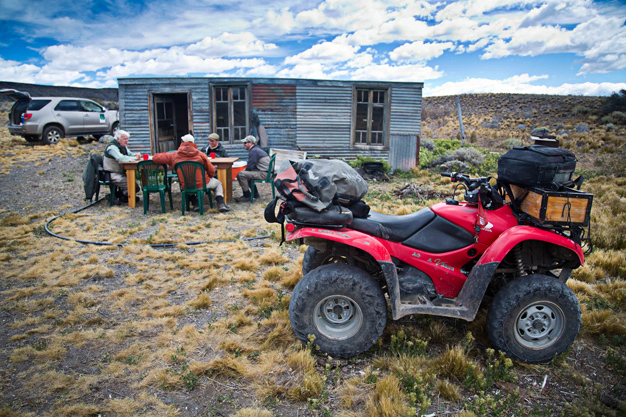 In the afternoon Frances and I hooked several more big rainbows – but it was hard work, with dozens of fish ignoring or refusing all manner of wets, dries and nymphs.
In the afternoon Frances and I hooked several more big rainbows – but it was hard work, with dozens of fish ignoring or refusing all manner of wets, dries and nymphs.
That night, back at the lodge, we enjoyed an open-air barbecue, the famous Argentinean asado, and were enthralled when the chef told us how a large puma had snuck into the yard and tried to make off with one of the lamb carcasses.
But somehow the talk again got stuck in a rut about fishing. Peter cheerily mocked the way I liked to hunt my quarry. ‘A strong preference for sight fishing is nothing but snobbery. Tomorrow I will be fishing blind with . It is preferable to hook up with something one hasn’t seen, something one doesn’t know the size of.’
Next morning the wind was blowing, and Christian happily predicted that the fishing would be much better. When we arrived at the south-eastern corner of Strobel there were plenty of whitecaps, but there wasn’t a cloud in the bright blue sky. Conditions were perfect for polaroiding.
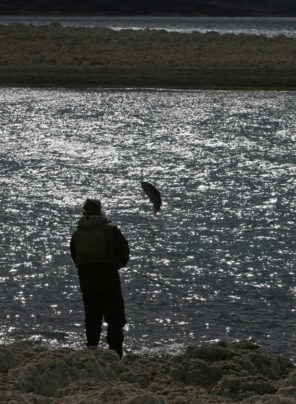
I’d read that heavy onshore waves tempt the trout in close, but that day most fish stayed well off shore in the deep blue water beyond a well-defined lip. Many were swimming open-mouthed through clouds of daphnia. Others were porpoising on midges. Some were even surfing down the faces of waves chasing yearling trout. I pleaded with Christian to fish with us: ‘There’s enough fish for everyone, and I want to maximise our chances of getting a photo of a twenty-pounder.’
He looked at the fish, then back at me. ‘I don’t suppose anyone will be offended if you don’t tell them.’
Although we had to haul twenty-metre casts into gale-force headwinds, we intercepted a lot of trout. But even the best presentations were often refused, prompting Christian to lament, ‘Really, it’s usually much easier than this.’ Frances and I didn’t mind: we were hooking fish often enough.
The big problem, for me at least, was getting broken off. Sometimes the fish would run along the shore among coral gardens of submerged tufa. Other times they’d take out a hundred metres of backing and then accelerate sideways, and simply by working against the friction of the line in the water they were able to straighten hooks. Still, we landed several ten-pound fish, a couple of fifteen pounders and a twenty pounder.
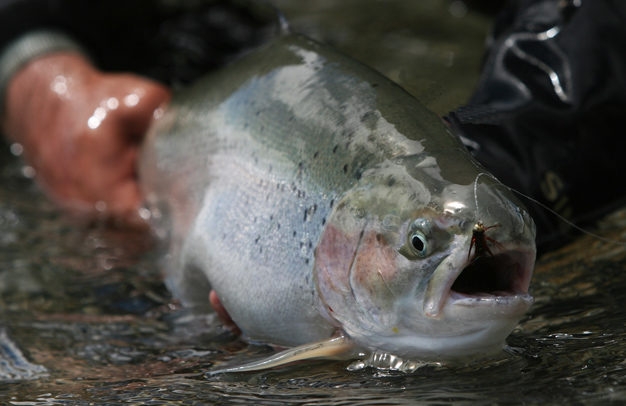 That evening around the dining table, Steven looked as though he’d been through the wringer. ‘How many ways can a man get broken off?’ he lamented.
That evening around the dining table, Steven looked as though he’d been through the wringer. ‘How many ways can a man get broken off?’ he lamented.
‘He lost eight in a row before finally landing some monsters in the afternoon,’ Peter elaborated.
Brad and Jan confessed to having great trouble casting into the wind, but they too managed to net a few good fish.
Max and Nigel, on the other hand, spoke of landing maybe thirty each. They were both exceptional casters, so they deserved to out-fish everyone else, but I was perplexed by their descriptions of three or four fish at a time tussling one another to be first to reach the fly. We didn’t experience any of that.
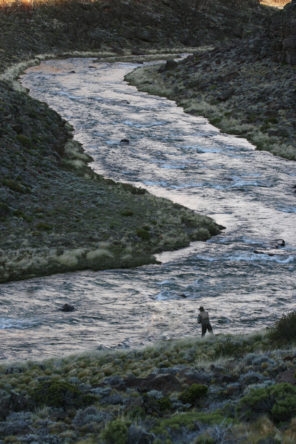
The last day
On the last day we fished Río Barrancoso, where we found some very big fish in two small broadwaters and lots of delightful one-pound residents in the pocket waters on the steeper sections.
That evening, as we packed our bags, we had a great time reflecting on the truly sensational fishing that we’d experienced.
Conservation notes
Patagonians highly value their wild trout, but there’s some commercial harvesting from lakes on private estancias.
*Greg French is a Tasmanian writer and author of the excellent recently published book Last Wild Trout and the earlier Fishing for Conservation, both from Affirm Press and Simon & Schuster. A recent interview with him can be read here.